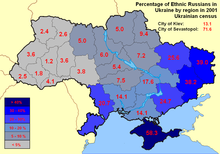Eastern Ukraine
The Eastern Ukraine is the eastern of the four major regions of Ukraine . The largest city, cultural and intellectual center of this region, which is characterized by heavy industry , is Kharkiv (Russian: Kharkov ). Other large industrial centers are Dnipro , Donetsk , Luhansk and Mariupol .
Spatial demarcation
history
In the course of history , both the east and the south of Ukraine have repeatedly and for a long time belonged to the steppe empires of the Eurasian nomadic and equestrian peoples of the Khazars , Kyptschaks (capital Sharukhan near Kharkiv) and Tatars ( Golden Horde on the Volga). After the collapse of Tatar and Lithuanian rule, in 1648 the Orthodox Cossacks of central Ukraine, led by Bohdan Khmelnyzkyj, rose up against the Catholic Poles and in 1654 stood to the left of the Dnieper river, all but then divided under Russian protection. In 1668 Poland had to recognize Russian rule over eastern and central Ukraine, including Kiev. Catherine the Great introduced serfdom , which was previously unknown in Ukraine . In 1793 and 1795, Russia also conquered most of the remaining Ottoman territories of Ukraine.
A spatial delimitation of eastern Ukraine is carried out in different ways. On the basis of historical development, it can be distinguished from the " left bank Ukraine " as part of central Ukraine, which includes the areas to the left of the Dnieper River and the capital Kiev , which is located on the right bank of the Dnieper , since these were parts of Poland-Lithuania. (The " right bank Ukraine " remained under Polish control until the partitions of Poland , only Galicia, located in the far west, and Carpathian Ukraine did not come under Soviet rule until the Second World War.)
Because of the large deposits of raw materials, the area was industrialized relatively early. In the Donetsk and Luhansk Oblasts in particular, the industrial area of the Donetsk Basin emerged in the second half of the 19th century . Dnipro , located between the coal mining area in the Donets Basin and the ore mining area around Krywyj Rih (Krivoy Rog) , is another important industrial city.
After the victory of the Soviets in the civil war and the suppression of Ukrainian independence movements, from 1920 to 1934 Kharkiv was instead of Kiev as the capital of the Ukrainian Soviet Republic . The Soviets pushed industrialization and shipping, exploiting agriculture (starvation exports). Millions of people died during the Holodomor (famine of 1932/33), many of them in the villages of eastern Ukraine, which together with central Ukraine was more affected than western Ukraine. The industrial development in eastern Ukraine led to a strong urbanization process and the immigration of workers from Russia, while western Ukraine is still partly very rural today.
population
The residents of Russian descent are mainly concentrated in the larger urban conurbations. In the larger cities and especially in the Oblasts of Donetsk and Luhansk, Russian is the dominant mother tongue, although Russian is also used as a lingua franca by many Ukrainians. The great importance of the Russian language in the cities of eastern Ukraine stems from the fact that, in the course of industrialization, many Russians immigrated to the newly founded cities in this area (especially from the Kursk Oblast ). For example, at the 1897 census, 63.17% of the population of Kharkiv city were of Russian descent. Almost the entire Jewish population, if not fled, was murdered during the German occupation in World War II.
In the Ukrainian regions of Luhansk (Russian Lugansk ; 39.0%), Donetsk (38.2%), Kharkiv (25.6%), Zaporozhye (Russian Zaporozhye ; 24.7%), Odessa (20.7%), There are large Russian minorities in Dnipropetrowsk (Russian Dnepropetrowsk ; 17.6%), Mykolaiv (Russian Nikolayev ) and Cherson (both 14.1%). (In the Autonomous Republic of Crimea (58.3%) and in the city of Sevastopol (71.6%), Russians make up the majority of the population compared to both Ukrainians and Crimean Tatars .)
The proportion of those who speak Russian as their mother tongue is higher than that of ethnic Russians, as there are also ethnic Ukrainians and members of other nationalities who state Russian as their mother tongue. The share is highest in the Autonomous Republic of Crimea (77.0%), Donetsk (74.9%), Luhansk (68.8%), Zaporizhia (48.2%) Kharkiv (44.3%) (and Odessa in southern Ukraine (41.9%)).
The inhabitants of eastern Ukraine are mostly atheistic, Ukrainian Orthodox with a commitment to the Moscow Patriarchate or Protestant (especially Baptists) - while in western Ukraine there are more Catholics, Greek Catholics and members of the Orthodox Church of Ukraine .
See also
Bibliography and Notes
- ^ Andreas Kappeler: Foreign rule burdens the Ukrainian population; Audio file SRF May 13, 2014 ( page no longer available , search in web archives ) Info: The link was automatically marked as defective. Please check the link according to the instructions and then remove this notice.
- ↑ 2001 Census: Nationalities
- ↑ 2001 Census: Languages



